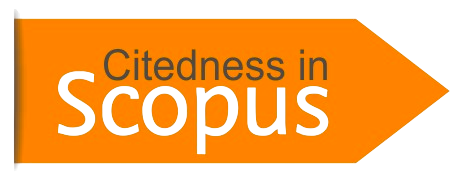Soil Organic Matter and Soil Organic Carbon in Barito Delta
DOI:
https://doi.org/10.30631/sdgs.v3i2.1854Keywords:
soil organic matter, soil organic carbon, barito deltaAbstract
Soil organic matter and soil organic carbon is essential indication of soil carbon stock in terrestrial ecosystem particularly in peatland. Spatial distribution of soil organic carbon and soil organic matter is primary assessment to predict future soil condition under climate change traits. Barito Delta is one of peatland areas in Kalimantan Island that experiences urban expansion. It is necessary to assess distribution of soil organic carbon and soil organic matter to define the potential traits of urbanization and climate change to carbon stock condition in this delta. Therefore, the aim of this research is to analyze the distribution of soil organic matter and soil organic carbon in Barito Delta. Fieldwork measurement is performed to take sample of soil organic matter for each layer within 5 m soil depth. Inverse distance weighting interpolation is used to determine the spatial distribution of soil organic matter (SOM) and soil organic carbon (SOC) applying in R software.
The value of SOM and SOC decrease along the increase of soil depth so that the largest percentage of SOM and SOC is in the first layer. Large value of SOM and SOC are mostly in the southern part of Barito Delta since it is bordered with sea water and downstream of rivers. The maximum value of SOM is ~12 % in the first layer, while 8.3 % of SOC in the first layer. Nevertheless, the value of SOC decrease in the near future, it is as indication Barito Delta contribute to carbon stock loss realizing to atmosphere that can rise greenhouse gasses and climate change.
References
Arisanty, D., Rahmawati, N., & Rosadi, D. (2022). Soil Physical Characteristics and Saturated Hydraulic Conductivity in the Landform of Barito Delta, Kalimantan, Indonesia. Applied and Environmental Soil Science, 2022, 9118461
Chen, F.-W., & Liu, C.-W. (2012). Estimation of the spatial rainfall distribution using inverse distance weighting (IDW) in the middle of Taiwan. Paddy and Water Environment, 10, 209-222
Fujisaki, K., Chevallier, T., Bispo, A., Laurent, J.B., Thevenin, F., Chapuis-Lardy, L., Cardinael, R., Le Bas, C., Freycon, V., Bénédet, F., Blanfort, V., Brossard, M., Tella, M., & Demenois, J. (2023). Semantics about soil organic carbon storage: DATA4C+, a comprehensive thesaurus and classification of management practices in agriculture and forestry. SOIL, 9, 89-100
Girkin, N.T., Vane, C.H., Cooper, H.V., Moss-Hayes, V., Craigon, J., Turner, B.L., Ostle, N., & Sjögersten, S. (2019). Spatial variability of organic matter properties determines methane fluxes in a tropical forested peatland. Biogeochemistry, 142, 231-245
Herzfeld, T., Heinke, J., Rolinski, S., & Müller, C. (2021). Soil organic carbon dynamics from agricultural management practices under climate change. Earth Syst. Dynam., 12, 1037-1055
Kambhammettu, B.V.N.P., Allena, P., & King, J.P. (2011). Application and evaluation of universal kriging for optimal contouring of groundwater levels. Journal of Earth System Science, 120, 413-422
Klingenfuß, C., Roßkopf, N., Walter, J., Heller, C., & Zeitz, J. (2014). Soil organic matter to soil organic carbon ratios of peatland soil substrates. Geoderma, 235-236, 410-417
Lawrence, C.R., Harden, J.W., Xu, X., Schulz, M.S., & Trumbore, S.E. (2015). Long-term controls on soil organic carbon with depth and time: A case study from the Cowlitz River Chronosequence, WA USA. Geoderma, 247-248, 73-87
Leifeld, J., Klein, K., & Wüst-Galley, C. (2020). Soil organic matter stoichiometry as indicator for peatland degradation. Scientific Reports, 10, 7634
Liu, Z.-N., Yu, X.-Y., Jia, L.-F., Wang, Y.-S., Song, Y.-C., & Meng, H.-D. (2021). The influence of distance weight on the inverse distance weighted method for ore-grade estimation. Scientific Reports, 11, 2689
Lourenco, M., Fitchett, J.M., & Woodborne, S. (2022). Peat definitions: A critical review. Progress in Physical Geography: Earth and Environment, 0, 03091333221118353
Lu, G.Y., & Wong, D.W. (2008). An adaptive inverse-distance weighting spatial interpolation technique. Computers & Geosciences, 34, 1044-1055
Maleika, W. (2020). Inverse distance weighting method optimization in the process of digital terrain model creation based on data collected from a multibeam echosounder. Applied Geomatics, 12, 397-407
Munyati, C., & Sinthumule, N.I. (2021). Comparative suitability of ordinary kriging and Inverse Distance Weighted interpolation for indicating intactness gradients on threatened savannah woodland and forest stands. Environmental and Sustainability Indicators, 12, 100151
Navarro-Pedreño, J., Almendro-Candel, M.B., & Zorpas, A.A. (2021). The Increase of Soil Organic Matter Reduces Global Warming, Myth or Reality? Sci, 3, 18
Negassa, W., Acksel, A., Eckhardt, K.-U., Regier, T., & Leinweber, P. (2019). Soil organic matter characteristics in drained and rewetted peatlands of northern Germany: Chemical and spectroscopic analyses. Geoderma, 353, 468-481
Oliver, M.A., & Webster, R. (2014). A tutorial guide to geostatistics: Computing and modelling variograms and kriging. CATENA, 113, 56-69
Paré, D., Laganière, J., Larocque, G.R., & Boutin, R. (2022). Effects of climate and forest composition on soil carbon cycling, soil organic matter stability and stocks in a humid boreal region. EGUsphere, 2022, 1-30
Plante, A., & Conant, R.T. (2014). Soil Organic Matter Dynamics, Climate Change Effects. In B. Freedman (Ed.), Global Environmental Change (pp. 317-323). Dordrecht: Springer Netherlands
Pribyl, D.W. (2010). A critical review of the conventional SOC to SOM conversion factor. Geoderma, 156, 75-83
Siewert, M.B. (2018). High-resolution digital mapping of soil organic carbon in permafrost terrain using machine learning: a case study in a sub-Arctic peatland environment. Biogeosciences, 15, 1663-1682
Smith, P., Fang, C., Dawson, J.J.C., & Moncrieff, J.B. (2008). Impact of Global Warming on Soil Organic Carbon. Advances in Agronomy (pp. 1-43): Academic Press
Worrall, F., Moody, C.S., Clay, G.D., Burt, T.P., & Rose, R. (2017). The flux of organic matter through a peatland ecosystem: The role of cellulose, lignin, and their control of the ecosystem oxidation state. Journal of Geophysical Research: Biogeosciences, 122, 1655-1671














